How 4 urban chapters are delivering on the Pheasants Forever mission
Story By Andrew Johnson
Lead Image By Alex Roth / Friends of the Mississippi
Pheasants Forever is a stalwart in rural areas where hunting is a way of life and upland habitat is just down the road. In fact, sometimes it’s easy to forget The Habitat Organization’s birthplace was in the heart of St. Paul, Minnesota — some miles from the nearest opportunity to put habitat on the ground, much less walk through it in search of a rooster.
Today, most of PF’s 760 chapters across the United States and Canada are based in rural areas and communities. However, a number of strong, active chapters are alive and well in cities across North America. Their passion for carrying PF’s conservation message and promoting outdoor heritage in metro areas is a common denominator shared with their rural counterparts.
Because simple logistics limit how habitat-centric their focus can be, chapters from the ’burbs have had to find unique ways to motivate themselves and craft how they deliver mission. To that end, here’s a look at Pheasants Forever in the city, and how four urban chapters are getting it done.
Metro Area Pheasants Forever – Minneapolis, Minnesota
A number of active chapters call the Twin Cities home, but the thing that stands out about the Metro Area chapter is they always show up, says Will Clayton, PF regional representative for eastern Minnesota.
“I have 37 chapters in my region — there’s more than 10 in and around the Twin Cities area — and they’re all great,” Clayton says. “But the thing about Metro is they’re always present at events or meetings, and they’re always willing to try new things. Year in and year out, if there’s a new program or if there’s something going on within the organization, you can bet they’ll be part of it.”
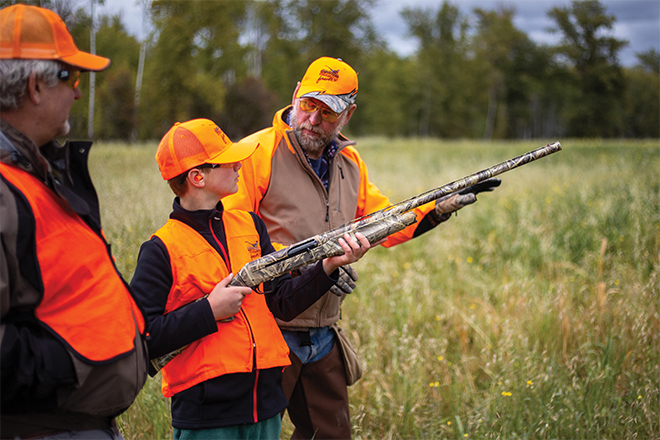
Clayton describes Metro Area as a holistic chapter that’s bought in at every level. For example, he says they dutifully donate to the PF Legislative Action Fund (LAF) and consistently contribute large amounts of money toward habitat projects in rural Minnesota.
“But if we’re talking about an R3 (Recruit, Retain, Reactive) component or introducing people to the outdoors, that’s where Metro has really flourished,” Clayton believes. “They’re committed to youth education and have developed a learn-to-hunt program that’s pretty special.”
“Our chapter made a decision years ago to teach kids how to shoot a shotgun,” says David Scherf, chapter president. “Unlike many rural chapters, we don't have land to develop for birds. But we have plenty of young people.”
Scherf says several MetroArea chapter members are NRA-certified instructors, and they’ve even developed a successful 5-step program to teach kids the basics of shooting a shotgun.
“We have used that 5-step method to teach hundreds of 10- to 12-year-old kids how to shoot,” Scherf reports. “We have even taught the method several different years at the Minnesota state conference to other interested PF chapter officers.”
In the past, the chapter has hosted its learn-to-shoot program on 5 consecutive Sundays each summer and fall, but this year’s program has been put on hold due to the ongoing coronavirus situation.
“During that program we teach two sessions per Sunday, with a max of about 24 kids a session,” Scherf says. “We provide everything — youth guns, shells, targets, hearing and eye protection — and each kid gets a vest to go hunting with.”
Scherf says the chapter then invites kids who have attended more than three sessions to a guided youth hunt at the Minnesota Horse and Hunt Club in nearby Prior Lake. In addition, he says each October the chapter also invites some learn-to-shoot participants to a wild bird hunt in the western part of the state sponsored by the Lyon County Pheasants Forever Chapter.
“Last year we started a new chapter initiative called Learn to Hunt,” Scherf explains. “Using graduates of our learn-to-shoot program and kids who are already grounded in shooting — trap-team kids, mostly — we teach the basics of going afield by themselves. This class includes a strong emphasis on safety in the field in a variety of situations, as well as using and operating different types of shotguns, bird cleaning and more.”
Interestingly, the chapter has elected not to organize any type of fundraising banquets for the last 10 years. Scherf points out that banquets are expensive and can be a tough sell in urban areas, where there’s simply too much going on and people’s attention is divided.
As a result, the chapter has come up with other inventive ways to generate funds.
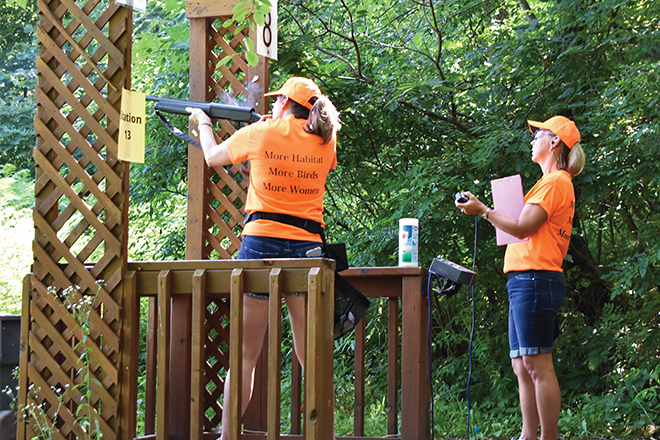
“We raise funds with one big raffle per year and by doing several different sporting clays shoots per year,” he explains. “The Shawn Garlinghouse Legacy Shoot, for example, supports our youth program. We also raise funds as partners with a fantastic group of women called The Bird Bustin' Babes, who do a land fundraiser each spring called Clays for a Cause. In 7 years we've helped these women raise $52,000, and every dime of profit has gone to permanently protect 1,518 acres in Minnesota through PF programs.”
Learn more at
metroareapf.org.
TallGrass Chapter of Pheasants Forever and Quail Forever – Chicago, Illinois
The TallGrass Chapter in Chicago, Ill., has also carried out PF’s mission by staying committed to conservation through public awareness and education directed at Chicagoland youth.
“This chapter is known for their incredible impact on the next generation of conservationists,” notes Ross Fogle, who was PF senior regional representative in northern Illinois. “Their local impact has direct results, and they activate their fundraising dollars to move the conservation needle forward. This chapter has a growing membership that makes incredible contributions to our No Child Left Indoors Initiative (NCLI), LAF and Illinois staff funding.”
Scott Krneta, who has been chapter president the last 4 years, says the chapter made up its mind to make firearms safety and awareness a priority — a tall task in Chicago where guns are in the headlines for all the wrong reasons.
“Here in the Chicagoland area, guns are viewed as an enemy instead of a tool. So about 5 or 6 years ago our chapter decided we were going to do something about the negative stigma surrounding guns by teaching kids firearms safety and how to shoot,” Krneta explains. “That first year we only had one event, but before coronavirus hit, we were up to 5 or 6 chapter shooting events a year.”
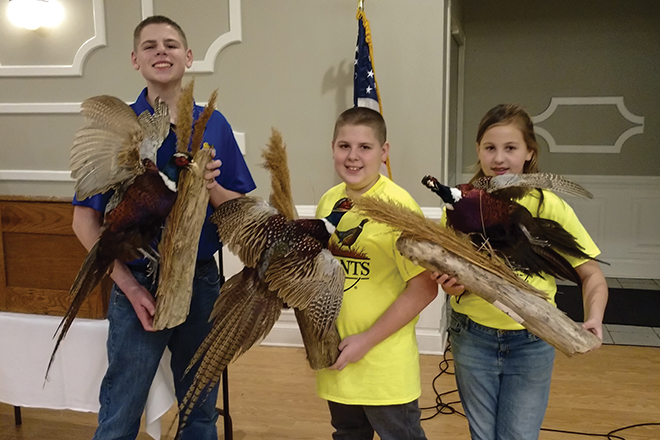
Additionally, Krneta says he and 4 other chapter volunteers not only teach firearms safety through chapter events, but they also participate as certified firearms instructors for hunter safety classes offered through the Illinois Department of Natural Resources (DNR).
“Helping with those classes only makes us better qualified to teach at our events,” he says. “It’s also just a ton of fun, and when you see the smile on a kid who’s never shot a gun before and breaks a target for the first time. It’s a pretty cool feeling. It’s something I didn’t have as a kid growing up in Chicago. I didn’t go hunting until I went to college in Iowa. That was 30 years ago, and I’ve been hooked ever since.”
But the chapter’s efforts extend beyond providing opportunities for youth. TallGrass has been an early adopter of R3 programming in Illinois, and have changed most of their shoots from being youth-only events to being open to anyone.
“We found parents would be bored at these events while their kids were literally having a blast,” Krneta says. “So as a board, we decided to open chapter-sponsored shooting events to everyone. We’ve had good luck so far, with good turnouts and whole families learning basic shooting skills, safe gun handling and just having fun.”
Krneta says the inclusive nature of the chapter’s events have helped foster a relationship with the local chapter of The Well Armed Woman, a nonprofit organization that organizes local groups of women around the country that meet monthly to practice, learn and grow as shooters. Krneta says not only do these women show up at shooting events, but they’ve also started to support the chapter’s mission with their pocketbooks.
“Last year we had almost 40 of these women show up at our banquet,” he reports. “That might not seem like a big number to some folks, but for us that was nearly 25% of our turnout.”
Going forward, the chapter wants to organize more mentored hunts for both youth and women hunters, and they also want to promote other outdoor activities, including archery. In that regard, Krneta says the chapter has developed a close working relationship with BowDoc Archery in Mokena, Illinois, where they’ve held several archery shoots for kids and women.
“Putting all these events on sure is expensive, but it’s the right thing to do,” Krneta concludes.
Learn more at
facebook.com/Habitatorganization.
Douglas County West Pheasants Forever – Omaha, Nebraska
Even though the Douglas County West (DCW) Pheasants Forever Chapter in Elkhorn, Nebraska, a suburb of Omaha, doesn’t have a lot of opportunities for habitat projects out its back door, they have taken a nearby wildlife management area under their wing, says Jerry McDonald, PF senior regional representative for eastern Nebraska.
“They’ve really helped make some great habitat improvements on the property,” McDonald says. “They have cleaned up the unwanted volunteer trees to expand the area’s grassland and have interceded with forbs to create prime habitat for ground nesting birds such as pheasants and quail.”
While the chapter makes the most of its limited ability to influence area habitat, McDonald says it’s really the chapter’s commitment to youth education that’s their calling card.
“DCW holds a youth mentor hunt each year for kids who have recently completed their hunter education course through the Nebraska Game and Parks Commission (NGPC),” McDonald continues. “When they found they did not always have an abundance of kids for these hunts, many of the committee members received their endorsement from NGPC to be hunter-education instructors and keep filling the pipeline of candidates for the annual youth mentor hunt.”
According to chapter president Ken Beukenhorst, the DCW chapter has been teaching hunters ed for nearly 10 years now, but the chapter has recently decided to take things a step further by trying to establish a youth chapter in the Omaha area.
“We got to thinking that we could take a group of high-school-aged kids who were interested in hunting and conservation, and help them become a sub-chapter of what we do,” Beukenhorst says. “So over the past two or three years we’ve gone from saying we need to do something different to taking steps to putting that into place. The last couple banquets, for example, we’ve had a very specific presentation where we basically asked people to raise their hand and give money to get this thing started. Coronavirus has kind of put a dent in our efforts, but we’re trying.”
Beukenhorst says some of the chapter’s current youth-related activities often have nothing to do with hunting at all. Instead, events like the chapter’s Canoe Day and activities such as archery, ziplining and high-adventure ropes courses take center stage.
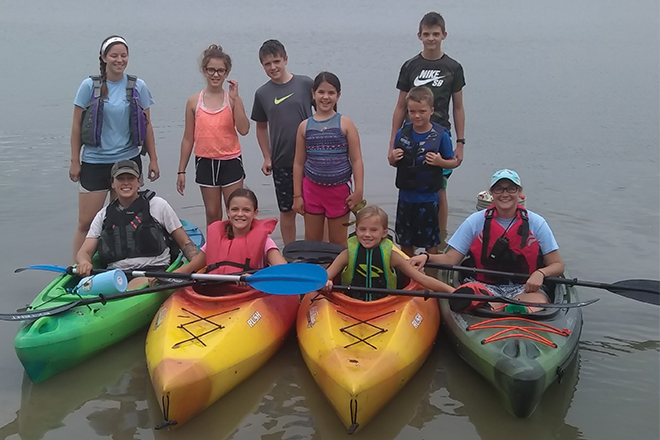
Another example of the chapter’s work in action is how they’ve partnered with Fontenelle Forest, a local conservation organization that owns and manages two nature centers, one in Omaha and another just down the road in Bellevue. The properties encompass over 2,100 acres of forest, prairie and wetlands along the Missouri River.
“The point is, we get kids outside to not only to do the fun part, but after that’s all over we take them on a hike away from all the distractions and talk about why we’re here and to plant the seed of what Pheasants Forever is and why conservation matters,” Beukenhorst says. “The idea is if we get enough of these kids to keep coming back, eventually something might click and we might be able to get this youth chapter going.”
DCW also sponsors local trap teams through the MidwayUSA Foundation shooting sports program. Beukenhorst hesitates to guess exactly how many trap teams the chapter has supported through the years, but he says he’d be remiss if he didn’t mention the chapter will continue supporting youth shooting sports, events and education programs well into the future.
“Why this approach and focus on youth? Well, PF has been making a big push on why pollinators are important and how they use the same habitat as pheasants and quail,” he says. “To get the message out there to a bunch of old hunters is difficult, so how do we do that? We start with kids who don’t have preconceived notions on how all this works. We also teach them that there’s more to the process than pulling a trigger.”
“That’s the seed we’re planting,” he states, “that you don’t need a gun to enjoy seeing and conserving wild places and wildlife.”
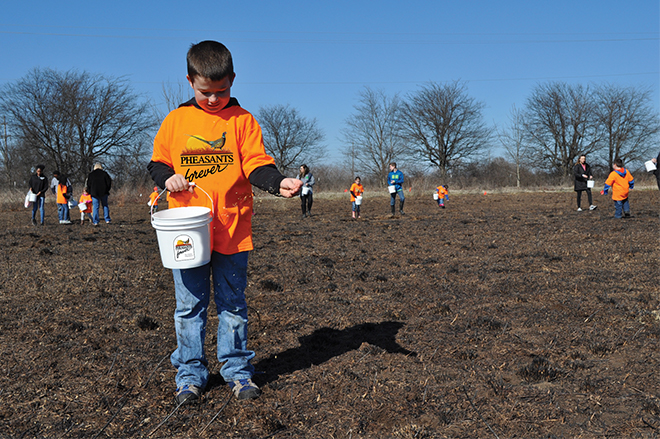
Outside of youth engagement, Beukenhorst says another focus of the chapter is habitat improvement and that they’re willing and able to assist other chapters or conservation entities with habitat projects. Problem is, they just haven’t had many takers.
“We’ve made it known that if the project or land is within a two-hour drive from Omaha, we’d love to provide matching funds or other financial assistance,” he says. “We’ve told other chapters and even PF biologists that we want to spend money, but we’ve only been asked maybe twice in the past 15 years to help out.”
Nebraska folks, are you listening?
Lear more at
dcwestpheasantsforever.org.
Johnson County Pheasants Forever and Quail Forever — Kansas City, Kansas
While the Johnson County Pheasants Forever and Quail Forever Chapter is active within the Kansas City community, it delivers PF’s mission well beyond city limits by supporting habitat, conservation and outdoor experiences for women and youth throughout the state of Kansas.
Trevor Day, PF’s regional field rep for northern Missouri and eastern Kansas, says the chapter’s mission is clearly on display each year during their annual banquet, when the chapter doles out lifetime Kansas hunting licenses for several lucky kids in attendance.
“They have a period during every live auction at their banquets where they gather all the kids in the room from a certain age range and hand out a dozen lifetime hunting permits, firearms and a whole suite of items,” Day explains. “It really takes everything to a new level and shows everyone in the room the chapter is dedicated to the future of hunting and fishing. I think this bodes well in the urban area because hunting and fishing aren’t things that every kid gets exposed to early on like in rural communities.”
JoCo, as it’s called by locals and chapter members alike, is just down the road from longtime PF supporters Garmin and CZ-USA, which doesn’t hurt when it comes to finding sponsors for chapter events such as shotgun shooting clinics, a youth or women’s hunt, hunter education courses, and habitat and pollinator projects.
“We are blessed to have a wonderful base of individual and corporate sponsors who truly believe in our mission and support our efforts to help get more youth and women involved in the outdoors,” says Jim Milazzo, JoCo chapter president. “We have hosted an annual youth and women’s pheasant hunt now for close to 20 years, and it is truly a family fun day that everyone looks forward to each year.”
In recent years, Milazzo says the chapter has started to financially support local high school and 4-H shooting sports teams.
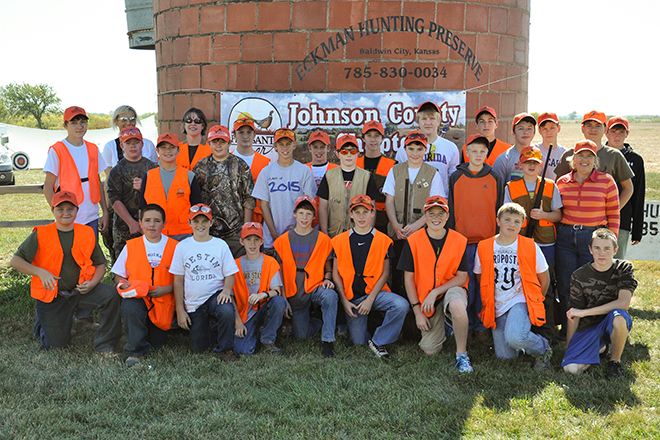
“These young men and women are already passionate about shooting, so it is a perfect way for us to spread our work and mission with those young minds to engage them in exploring conservation and hunting opportunities,” he says. “We’ve also found there’s a tremendous need to hold more hunter-education certification classes, so a number of our officers became instructors so we could hold our own classes.”
Speaking of officers, Milazzo makes special note of the fact the chapter has also embraced two new officer positions held by women who are highly passionate about the outdoors.
“They’ve actually started their own organizations — Wander Woman and WildHERness,” he says. “Jessica White and Jessica Rice and their organizations are totally focused on increasing the number of women in shooting sports and hunting.”
Learn more at
jocopheasantsforever.org.
Conclusion
Bottom line? The chapters profiled here and many others embrace their urban locations. They take advantage of their unique voice within their respective communities to promote Pheasants Forever’s message, support habitat efforts, and recruit tomorrow’s hunters and conservationists. It’s tough, necessary work. But as TallGrass’s Krneta says, “It’s the right thing to do.”
GET GOING
Inspired? Got ideas? No matter where you live, you can start a chapter too. Contact the PF Field Representative for your state or region and get going!
Andrew Johnson reports on a variety of conservation topics for Pheasant Forever.
Alex Roth, ecologist with Friends of the Mississippi River, took the lead photograph at a prairie restoration site at Ole Olson Park in Minneapolis.
This article first appeared in the Winter 2021 Issue of Pheasants Forever Journal.